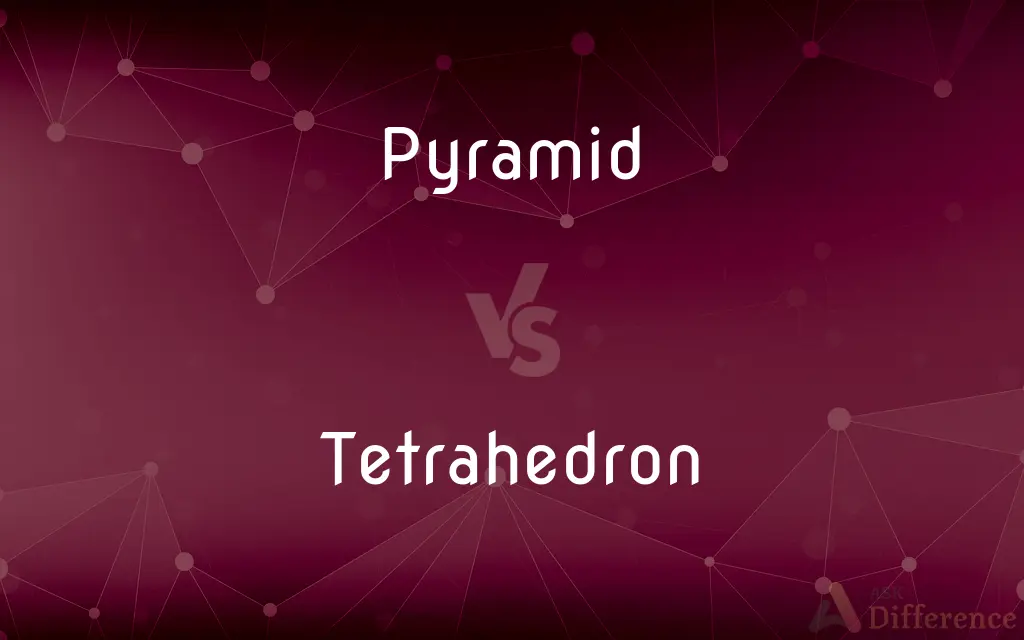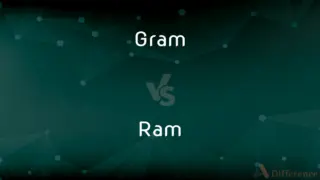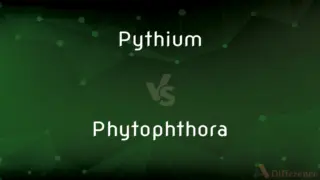Pyramid vs. Tetrahedron — What's the Difference?
By Tayyaba Rehman & Urooj Arif — Updated on August 8, 2024
A pyramid is a polyhedron with a polygonal base and triangular faces meeting at a common point, while a tetrahedron is a specific type of pyramid with four triangular faces.

Difference Between Pyramid and Tetrahedron
Table of Contents
ADVERTISEMENT
Key Differences
A pyramid can have any polygonal shape as its base, resulting in various forms such as square pyramids or triangular pyramids, depending on the base's shape. This diversity in base shapes allows for a wide range of pyramid structures, from those seen in ancient architectures to modern mathematical models. On the other hand, a tetrahedron is a kind of pyramid that specifically has a triangular base, making it the simplest form of a pyramid with only four faces, each of which is an equilateral triangle in the regular tetrahedron case.
The geometric properties of a pyramid are largely determined by the shape of its base and the height of the pyramid. For example, the volume of a pyramid can be calculated as one-third the product of the base area and the perpendicular height. Tetrahedrons, being a subset of pyramids, follow the same rule for volume calculation, but due to their uniform triangular faces, calculating their properties, such as volume and surface area, involves more specific formulas tailored to triangles.
In terms of symmetry, pyramids can vary greatly. A pyramid with a regular polygon base and equal slant heights has rotational symmetry around the axis through its apex and the center of its base. In contrast, a regular tetrahedron exhibits not only rotational symmetry but also equal edge lengths and angles, making it highly symmetric among pyramids.
Both pyramids and tetrahedrons serve as fundamental elements in various fields such as architecture, mathematics, and crystallography. Pyramids have been iconic in architectural designs, symbolizing stability and permanence, while tetrahedrons play a critical role in studying molecular structures and spatial relations in geometry.
Comparison Chart
Base Shape
Any polygon (triangle, square, etc.)
Triangle only
ADVERTISEMENT
Number of Faces
At least four, depending on the base
Four (including the base)
Symmetry
Varies with the shape of the base and arrangement of faces
High symmetry, with all faces being equilateral triangles in a regular tetrahedron
Uses
Architecture, art, geometry
Mathematics, crystallography, molecular studies
Specificity
General category of polyhedra
Specific type of pyramid
Compare with Definitions
Pyramid
Used symbolically in architecture and art.
Pyramids are often used to represent stability and durability.
Tetrahedron
A polyhedron with four triangular faces.
A regular tetrahedron has four equilateral triangles.
Pyramid
A subject of geometric study.
Geometrically, a pyramid's volume can be calculated using its base area and height.
Tetrahedron
Exhibits equal edge lengths in its regular form.
In a regular tetrahedron, all edges are congruent.
Pyramid
Found in various cultures worldwide.
Pyramids were built as monumental structures in ancient Egypt and Mesoamerica.
Tetrahedron
The simplest form of a pyramid.
A tetrahedron is essentially a pyramid with a triangular base.
Pyramid
A structure with a polygonal base and triangular sides that converge to a point.
The Great Pyramid of Giza is a monumental square-based pyramid.
Tetrahedron
Used in molecular and crystal studies.
The methane molecule has a tetrahedral shape.
Pyramid
Varies in shape based on the base.
A pentagonal pyramid has a five-sided base and five triangular faces.
Tetrahedron
Has a specific volume formula based on edge length.
The volume of a regular tetrahedron can be directly calculated from its edge length.
Pyramid
A pyramid (from Greek: πυραμίς pyramís) is a structure whose outer surfaces are triangular and converge to a single step at the top, making the shape roughly a pyramid in the geometric sense. The base of a pyramid can be trilateral, quadrilateral, or of any polygon shape.
Tetrahedron
In geometry, a tetrahedron (plural: tetrahedra or tetrahedrons), also known as a triangular pyramid, is a polyhedron composed of four triangular faces, six straight edges, and four vertex corners. The tetrahedron is the simplest of all the ordinary convex polyhedra and the only one that has fewer than 5 faces.The tetrahedron is the three-dimensional case of the more general concept of a Euclidean simplex, and may thus also be called a 3-simplex.
Pyramid
A monumental structure with a square or triangular base and sloping sides that meet in a point at the top, especially one built of stone as a royal tomb in ancient Egypt.
Tetrahedron
A polyhedron with four faces.
Pyramid
An object, shape, or arrangement in the form of a pyramid
A pyramid of logs
A pyramid roof
Tetrahedron
A polyhedron with four faces; the regular tetrahedron, the faces of which are equal equilateral triangles, is one of the Platonic solids.
Pyramid
A system of financial growth achieved by a small initial investment, with subsequent investments being funded by using unrealized profits as collateral
The eventual collapse of illegal pyramids
Tetrahedron
A solid figure inclosed or bounded by four triangles.
Pyramid
Stack or arrange in the shape of a pyramid.
Tetrahedron
Any polyhedron having four plane faces
Pyramid
Achieve a substantial return on (money or property) after making a small initial investment
A bank can pyramid modest capital into an enormous sum of money
Pyramid
A solid figure with a polygonal base and triangular faces that meet at a common point.
Pyramid
Something shaped like this polyhedron.
Pyramid
A massive monument of ancient Egypt having a rectangular base and four triangular faces culminating in a single apex, built over or around a crypt or tomb.
Pyramid
Any of various similar constructions, especially a four-sided Mesoamerican temple having stepped sides and a flat top surmounted by chambers.
Pyramid
The transactions involved in pyramiding stock.
Pyramid
(Anatomy) A structure or part suggestive of a pyramid in shape.
Pyramid
To place or build in the shape of a pyramid.
Pyramid
To build (an argument or thesis, for example) progressively from a basic general premise.
Pyramid
To speculate in (stock) by making a series of buying and selling transactions in which paper profits are used as margin for buying more stock.
Pyramid
To assume the shape of a pyramid.
Pyramid
To increase rapidly and on a widening base.
Pyramid
To pyramid stocks.
Pyramid
An ancient massive construction with a square or rectangular base and four triangular sides meeting in an apex, such as those built as tombs in Egypt or as bases for temples in Mesoamerica.
Pyramid
A construction in the shape of a pyramid, usually with a square or rectangular base.
Pyramid
(geometry) A solid with triangular lateral faces and a polygonal (often square or rectangular) base.
Pyramid
(neuroanatomy) A medullary pyramid, the medial-most bumps on the ventral side of the medulla oblongata
Pyramid
The game of pool in which the balls are placed in the form of a triangle at spot.
Pyramid
A pyramid scheme.
Pyramid
Alternative case form of Pyramid}}. {{gloss
Pyramid
(card games) The triangular layout of cards in the game of Pyramid.
Build your pyramid with all cards face down, except the cards in the bottom row.
Pyramid
(journalism) An approximately triangular headline consisting of several centered lines of text of increasing length.
Pyramid
To build up or be arranged in the form of a pyramid.
Pyramid
To combine (a series of genes) into a single genotype.
Pyramid
(intransitive) To employ, or take part in, a pyramid scheme.
Pyramid
(finance) To engage in pyramid trading.
Pyramid
A solid body standing on a triangular, square, or polygonal base, and terminating in a point at the top; especially, a structure or edifice of this shape.
Pyramid
A solid figure contained by a plane rectilineal figure as base and several triangles which have a common vertex and whose bases are sides of the base.
Pyramid
The game of pool in which the balls are placed in the form of a triangle at spot.
Pyramid
A fraudulent investment scheme in which the manager promises high profits, but instead of investing the money in a genuine profit-making activity, uses the money from later investors to pay the profits to earlier investors; - also called pyramid scheme or pyramid operation. This process inevitably collapses when insufficient new investors are available, leaving the later investors with total or near-total losses of their investments. The managers usually blame government regulations or interference for the collapse of the scheme, rather than admit fraud.
Pyramid
To enlarge one's holding or interest in a series of operations on a continued rise or decline by using the profits to buy or sell additional amounts on a margin, as where one buys on a 10% margin 100 shares of stock quoted at 100, holds it till it rises to 105, and then uses the paper profit to buy 50 shares more, etc. The series of operations constitutes a pyramid. A similar process of reinvesting gains or winnings (as of a gamble), but not involving operation on margin, is called a parlay.
Pyramid
A polyhedron having a polygonal base and triangular sides with a common vertex
Pyramid
(stock market) a series of transactions in which the speculator increases his holdings by using the rising market value of those holdings as margin for further purchases
Pyramid
A massive memorial with a square base and four triangular sides; built as royal tombs in ancient Egypt
Pyramid
Enlarge one's holdings on an exchange on a continued rise by using paper profits as margin to buy additional amounts
Pyramid
Use or deal in (as of stock or commercial transaction) in a pyramid deal
Pyramid
Arrange or build up as if on the base of a pyramid
Pyramid
Increase rapidly and progressively step by step on a broad base
Common Curiosities
What is a pyramid?
A pyramid is a polyhedron with a polygonal base and triangular faces that converge at a point.
How do the bases of pyramids and tetrahedrons differ?
Pyramids can have any polygon as their base, whereas tetrahedrons have only a triangular base.
Can all pyramids be considered tetrahedrons?
No, only pyramids with triangular bases can be considered tetrahedrons.
Are tetrahedrons always regular?
No, but a regular tetrahedron has equilateral triangles as its faces.
Is there a geometric difference between pyramids and prisms?
Yes, pyramids converge to a point, while prisms have two parallel, congruent bases.
What is a tetrahedron?
A tetrahedron is a type of pyramid with four triangular faces.
How do pyramids and tetrahedrons relate to geometry?
Both are studied in geometry for their properties, including volume and surface area calculations.
Why is the tetrahedron important in crystallography?
The tetrahedron helps in understanding molecular structures and spatial relationships in crystals.
What is the volume formula for a pyramid?
The volume of a pyramid is one-third the product of the base area and the height.
What is the significance of the Great Pyramid of Giza?
It's one of the ancient world's wonders, showcasing the architectural prowess of ancient Egyptians.
How many faces does a tetrahedron have?
A tetrahedron has four faces.
What roles do pyramids play in architecture?
Pyramids are iconic in architecture, symbolizing stability and used in monumental structures.
How does the symmetry of a pyramid compare to that of a tetrahedron?
Pyramids' symmetry varies with their base, while a regular tetrahedron has high symmetry with equal faces and angles.
What practical uses do tetrahedrons have?
Beyond mathematical interest, tetrahedrons are used in molecular modeling and structural engineering.
Can the base of a pyramid be circular?
Technically, a structure with a circular base and a pointed top is called a cone, not a pyramid.
Share Your Discovery

Previous Comparison
Gram vs. Ram
Next Comparison
Pythium vs. PhytophthoraAuthor Spotlight
Written by
Tayyaba RehmanTayyaba Rehman is a distinguished writer, currently serving as a primary contributor to askdifference.com. As a researcher in semantics and etymology, Tayyaba's passion for the complexity of languages and their distinctions has found a perfect home on the platform. Tayyaba delves into the intricacies of language, distinguishing between commonly confused words and phrases, thereby providing clarity for readers worldwide.
Co-written by
Urooj ArifUrooj is a skilled content writer at Ask Difference, known for her exceptional ability to simplify complex topics into engaging and informative content. With a passion for research and a flair for clear, concise writing, she consistently delivers articles that resonate with our diverse audience.













































